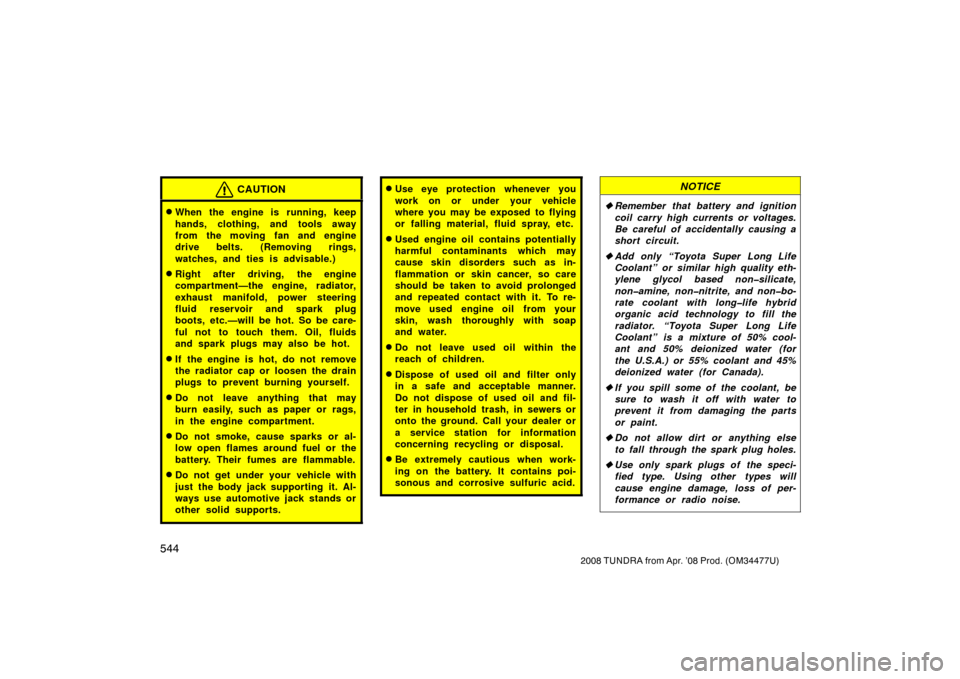Page 546 of 621

536
2008 TUNDRA from Apr. ’08 Prod. (OM 34477U)
Exhaust system
If you notice any change in the sound of
the exhaust or smell exhaust fumes, have
the cause located and corrected immedi-
ately. (See “Engine exhaust cautions” on
page 447 in Section 2.)
INSIDE THE VEHICLE
Items listed below should be checked
regularly, e.g. while performing periodic
services, cleaning the vehicle, etc.
Lights
Make sure the headlights, stop lights, tail
lights, turn signal lights, and other lights
are all working. Check headlight aim.
Service reminder indicators and warning
buzzers
Check that all service reminder indicators
and warning buzzers function properly.
Steering wheel
Be alert for changes in steering condition,
such as hard steering or strange noise. Seats
Check that all seat controls such as seat
adjusters, seatback recliner, etc. operate
smoothly and that all latches lock securely
in any position. Check that the head re-
straints move up and down smoothly and
that the locks hold securely in any latched
position. For folding
−down seatback (Reg-
ular cab and Crew Max models) and lift
up seat cushion (Double cab models),
check that the latches lock securely.
Seat belts
Check that the seat belt system such as
buckles, retractors and anchors operate
properly and smoothly. Make sure the belt
webbing is not cut, frayed, worn or dam-
aged.
Accelerator pedal
Check the pedal for smooth operation and
uneven pedal effort or catching.
Brake pedal
Check the pedal for smooth operation and
that the pedal has the proper clearance.
Check the brake booster function. Brakes
In a safe place, check that the brakes do
not pull to one side when applied.
Parking brake
Check that the pedal has the proper travel
and that, on a safe incline, your vehicle
is held securely with only the parking
brake applied.
Automatic transmission “Park” mecha-
nism
On a safe incline, check that your vehicle
is held securely with the selector lever in
“P” position and all brakes released.
OUTSIDE THE VEHICLE
Items listed below should be performed
from time to time, unless otherwise
specified.
Fluid leaks
Check underneath for leaking fuel, oil, wa-
ter or other fluid after the vehicle has
been parked for a while. If you smell fuel
fumes or notice any leak, have the cause
found and corrected immediately.
Page 550 of 621
540
2008 TUNDRA from Apr. ’08 Prod. (OM 34477U)
1. Windshield washer fluid tank
2. Engine oil level dipstick
3. Engine coolant reservoir
4. Engine oil filler cap
5. Brake fluid reservoir
6. Fuse block
7. Battery
8. Radiator
9. Condenser
10. Power steering fluid reservoir
Engine compartment overview
� 4.0 L V6 (1GR�FE) engine
XS71001a
Page 551 of 621
541
2008 TUNDRA from Apr. ’08 Prod. (OM 34477U)
1. Windshield washer fluid tank
2. Engine oil level dipstick
3. Engine coolant reservoir
4. Engine oil filler cap
5. Brake fluid reservoir
6. Fuse block
7. Battery
8. Radiator
9. Condenser
10. Power steering fluid reservoir
�
4.7 L V8 (2UZ�FE) engine
XS71002a
Page 552 of 621
542
2008 TUNDRA from Apr. ’08 Prod. (OM 34477U)
1. Windshield washer fluid tank
2. Engine oil level dipstick
3. Engine coolant reservoir
4. Engine oil filler cap
5. Brake fluid reservoir
6. Fuse block
7. Battery
8. Radiator
9. Condenser
10. Power steering fluid reservoir
�
5.7 L V8 (3UR�FE) engine
XS71003a
Page 554 of 621

544
2008 TUNDRA from Apr. ’08 Prod. (OM 34477U)
CAUTION
�When the engine is running, keep
hands, clothing, and tools away
from the moving fan and engine
drive belts. (Removing rings,
watches, and ties is advisable.)
�Right after driving, the engine
compartment—the engine, radiator,
exhaust manifold, power steering
fluid reservoir and spark plug
boots, etc.—will be hot. So be care-
ful not to touch them. Oil, fluids
and spark plugs may also be hot.
�If the engine is hot, do not remove
the radiator cap or loosen the drain
plugs to prevent burning yourself.
�Do not leave anything that may
burn easily, such as paper or rags,
in the engine compartment.
�Do not smoke, cause sparks or al-
low open flames around fuel or the
battery. Their fumes are flammable.
�Do not get under your vehicle with
just the body jack supporting it. Al-
ways use automotive jack stands or
other solid supports.
�Use eye protection whenever you
work on or under your vehicle
where you may be exposed to flying
or falling material, fluid spray, etc.
�Used engine oil contains potentially
harmful contaminants which may
cause skin disorders such as in-
flammation or skin cancer, so care
should be taken to avoid prolonged
and repeated contact with it. To re-
move used engine oil from your
skin, wash thoroughly with soap
and water.
�Do not leave used oil within the
reach of children.
�Dispose of used oil and filter only
in a safe and acceptable manner.
Do not dispose of used oil and fil-
ter in household trash, in sewers or
onto the ground. Call your dealer or
a service station for information
concerning recycling or disposal.
�Be extremely cautious when work-
ing on the battery. It contains poi-
sonous and corrosive sulfuric acid.
NOTICE
�Remember that battery and ignition
coil carry high currents or voltages.
Be careful of accidentally causing a
short circuit.
� Add only “Toyota Super Long Life
Coolant” or similar high quality eth-
ylene glycol based non�silicate,
non�amine, non�nitrite, and non�bo-
rate coolant with long�life hybrid
organic acid technology to fill the
radiator. “Toyota Super Long Life
Coolant” is a mixture of 50% cool-
ant and 50% deionized water (for
the U.S.A.) or 55% coolant and 45%
deionized water (for Canada).
� If you spill some of the coolant, be
sure to wash it off with water to
prevent it from damaging the parts
or paint.
� Do not allow dirt or anything else
to fall through the spark plug holes.
� Use only spark plugs of the speci-
fied type. Using other types will
cause engine damage, loss of per-
formance or radio noise.
Page 555 of 621

545
2008 TUNDRA from Apr. ’08 Prod. (OM 34477U)
�Do not reuse iridium�tipped spark
plugs by cleaning or regapping.
� Do not overfill automatic transmis-
sion fluid, or the transmission
could be damaged.
� Do not drive with the air cleaner
filter removed, or excessive engine
wear could result. Also backfiring
could cause a fire in the engine
compartment.
� Be careful not to scratch the glass
surface with the wiper frame.
� When closing the engine hood,
check to see that you have not for-
gotten any tools, rags, etc.Here is a list of parts and tools you will
need to perform do− it−yourself mainte-
nance. Remember all Toyota parts are de-
signed in metric sizes, so your tools must
be metric.
CHECKING THE ENGINE OIL LEVEL
Parts (if level is low):
�“Toyota Genuine Motor Oil” or equiva-
lent
See page 548 in Section 7 −2 for de-
tails about engine oil selection.
Tools:
�Rag or paper towel
�Funnel (only for adding oil)
CHECKING THE ENGINE COOLANT
LEVEL
Parts (if level is low):
�“Toyota Super Long Life Coolant” or
similar high quality ethylene glycol
based non −silicate, non −amine, non− ni-
trite, and non −borate coolant with long −
life hybrid organic acid technology.
“Toyota Super Long Life Coolant” is a
mixture of 50% coolant and 50% deion-
ized water(for the U.S.A.) or 55% cool-
ant and 45% deionized water (for Can-
ada). Tools:
�Funnel (only for adding coolant)
CHECKING BRAKE FLUID
Parts (if level is low):
�SAE J1703 or FMVSS No.116 DOT 3
brake fluid
Tools:
�Rag or paper towel
�Funnel (only for adding fluid)
CHECKING POWER STEERING FLUID
Parts (if level is low):
�Automatic transmission fluid
DEXRON �II or III
Tools:
�Rag or paper towel
�Funnel (only for adding fluid)
CHECKING BATTERY CONDITION
Tools:
�Warm water
�Baking soda
�Grease
�Conventional wrench (for terminal
clamp bolts)
Parts and tools
Page 557 of 621

547
2008 TUNDRA from Apr. ’08 Prod. (OM 34477U)
DO�IT�YOURSELF MAINTENANCE
Engine and Chassis
Checking the engine oil level 548
. . . . . . . . . . . . . . . . . . . . . . . . . . . . . . . . .
Checking the engine coolant level 551
. . . . . . . . . . . . . . . . . . . . . . . . . . . .
Checking the radiator and condenser 552
. . . . . . . . . . . . . . . . . . . . . . . . .
Checking brake fluid 552
. . . . . . . . . . . . . . . . . . . . . . . . . . . . . . . . . . . . \
. . . .
Checking power steering fluid 553
. . . . . . . . . . . . . . . . . . . . . . . . . . . . . . . .
Checking tire inflation pressure 553
. . . . . . . . . . . . . . . . . . . . . . . . . . . . . .
Checking and replacing tires 556
. . . . . . . . . . . . . . . . . . . . . . . . . . . . . . . . .
Rotating tires 558
. . . . . . . . . . . . . . . . . . . . . . . . . . . . . . . . . . . . \
. . . . . . . . . . .
Installing snow tires and chains 559
. . . . . . . . . . . . . . . . . . . . . . . . . . . . . .
Replacing wheels 561
. . . . . . . . . . . . . . . . . . . . . . . . . . . . . . . . . . . . \
. . . . . . .
Wheel precautions 562
. . . . . . . . . . . . . . . . . . . . . . . . . . . . . . . . . . . . \
. . . . . .
SECTION 7� 2
Page 558 of 621

548
2008 TUNDRA from Apr. ’08 Prod. (OM 34477U)
LS72004
Low level Full level
Add oil O.K. Too full
4.0 L V6 (1GR�FE) engine
XS72001a
Low level Full level
Add oil O.K. Too full
4.7 L V8 (2UZ�FE) engine
XS72002
Low level Full level
Add oil O.K. Too full
5.7 L V8 (3UR�FE) engine
With the engine at operating tempera-
ture and turned off, check the oil level
on the dipstick.
1. To get a correct reading, the vehicle should be on level ground. After turning
off the engine, wait a few minutes for
the oil to drain back into the bottom of
the engine.
2. Pull the dipstick out, hold a rag under the end and wipe it clean.
3. Reinsert the dipstick—push it in as far as it will go, or the reading will not be
correct. 4. Pull the dipstick out and look at the oil
level while holding a rag under the
end.
CAUTION
Be careful not to touch the hot ex-
haust manifold.
NOTICE
Be careful not to drop engine oil on
the vehicle components.
If the oil level is below or only slightly
above the low level, add engine oil of
the same type as already in the engine.
Remove the oil filler cap and add engine
oil in small quantities at a time, checking
the dipstick. We recommend that you use
a funnel when adding oil.
The approximate quantity of oil needed to
raise the level between low and full on the
dipstick is indicated as follows:
4.0 L V6 (1GR −FE) and 4.7 L V8 (2UZ −
FE) engine 1.5 L (1.6 qt., 1.3 Imp.qt.)
5.7 L V8 (3UR −FE) engine
1.1 L (1.2 qt., 1.0 Imp.qt.)
Checking the engine oil level